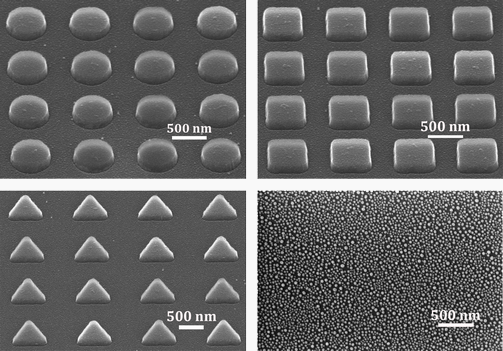SERS Substrates
Amplification of Raman Spectra up to 108
- No hot spots. Homogeneous amplification across the whole substrate
- Reusable SERS substrates with passivated coating
- SERS substrates for 532, 637, 785, and 1064 nm wavelengths
- Customized SERS substrates from Ag and Au
- Customized solutions in the wavelength range (400 - 1200) nm

Raman spectroscopy has been recognized as a reliable, accurate, and time-efficient method of the chemical structure of matter on a molecular scale. However, this technique has a critical limitation — as ordinary molecules and germs have a fairly small scattering cross-section, they produce a rather weak Raman response. The technology of surface-enhanced Raman scattering of light (SERS) has been employed to substantially boost Raman spectroscopy's sensitivity. The effect is achieved when a sample substance is placed on special nanostructured surfaces, which concentrate the electromagnetic field of laser radiation. Remarkably, it results in Raman signal amplification of many orders of magnitude. The Raman spectrum contains a number of narrow resonance lines, each of which corresponds to a specific vibrational/rotational molecular resonance. Thus, any substance or microorganism has its own set of characteristic Raman scattering lines, the so-called spectral «fingerprint.» Therefore, SERS is a powerful and highly effective tool for chemical substance identification and analysis.
RamanLife produces SERS biochips for express identification of various viruses:
(SARS-CoV-2, A/H1N1, A/H3N2, A/H5N1, A/H5N3, A/H12N2).
For these purposes, successful research and synthesis of a collection of aptamers based on nucleic acids have been carried out.
In this case, aptamers act as recognition elements for each type of virus. Based on the results of the research work, a line of SERS biochips was created, which effectively operate at various excitation wavelengths in the visible and IR spectral ranges (532, 633, 785, and 1064 nm).
SERS technology
In theory, SERS substrates enable two distinct mechanisms of magnifying the intensity of Raman scattering. One process is of the electromagnetic nature, whereby the investigated substance, placed in the vicinity of the substrate surface, couples to a localized electric field amplified by nanostructures on the surface of the substrate. In this case, the electric field lines become maximally dense in the regions of least separation between the metal nanoparticles due to the excitation of surface plasmon-polariton waves. Therefore, considering the square dependence of the Raman intensity on the induced dipole moment, which in turn is proportional to the product of the polarizability and magnitude of the incident electromagnetic field, the net gain in Raman response is equal to the ratio of the local and incident electric fields raised to the 4th power:
R = |Eloc|4/|E0|4
SERS substrates at
Single-molecule SERS
The second process is known as a chemical, or charge transfer mechanism. Unlike the electromagnetic case, it involves placing the investigated molecule or cluster of molecules in direct contact with the substrate surface. Thereby, the charge exchange between the substrate nanoparticles and the specimen molecules, in effect, increases the scattering cross-section of the particles. Furthermore, such a junction leads to higher polarizability and, as a consequence, results in additional enhancement of the overall intensity of Raman scattering.
In practical terms, the single-molecule SERS amplification due to the surface plasmon mechanism can reach a factor of approximately 106-107, with a maximum possible figure of 109 achievable under certain conditions. The ultimate enhancement effect of this process by far exceeds that of the chemical mechanism, which can at most produce Raman intensity gain on the order of 102.
